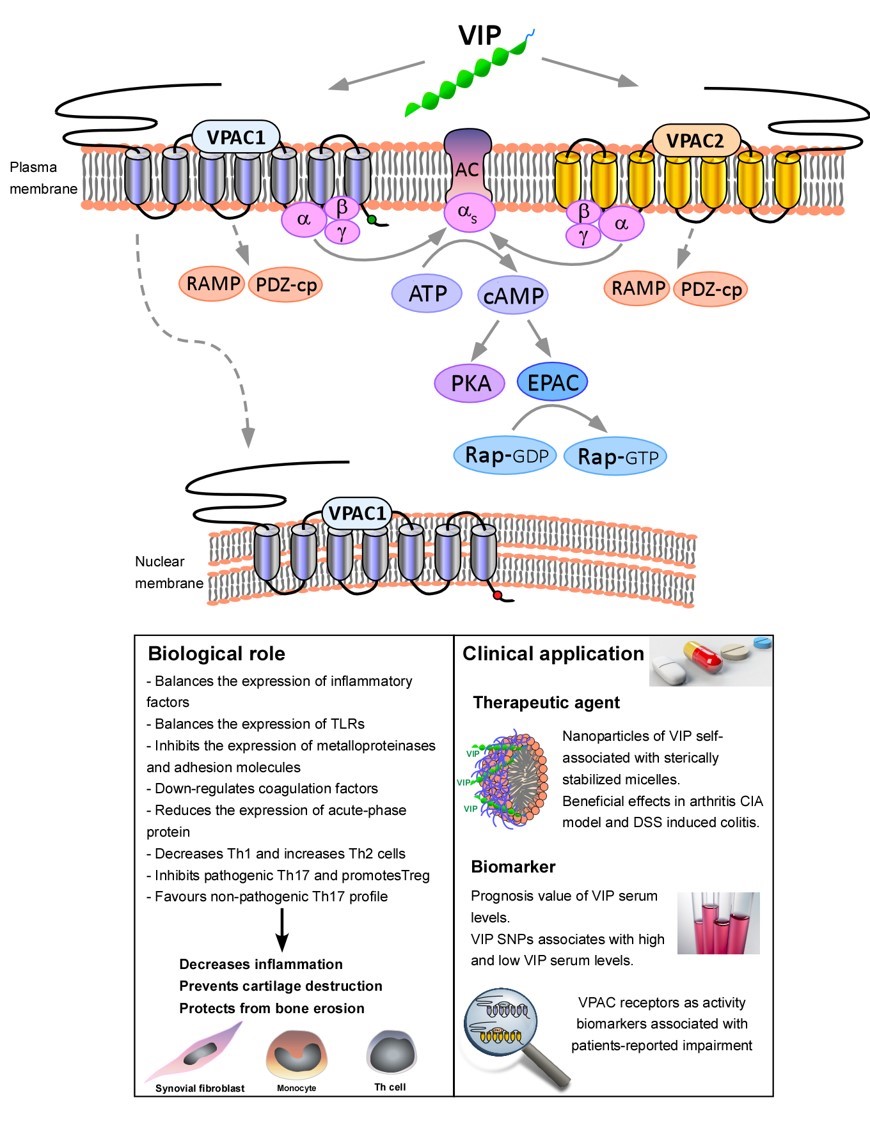Rosa P. Gomariz, Yasmina Juarranz, Mar Carrión, Selene Pérez-García, Raúl Villanueva-Romero, Isidoro González-Álvaro, Irene Gutiérrez-Cañas, Amalia Lamana, Carmen Martínez.
An overview of VPAC receptors in rheumatoid arthritis: biological role and clinical significance
Front. Endocrinol., 22 October 2019
DOI: 10.3389/fendo.2019.00729
RESUMEN
The axis comprised by the Vasoactive Intestinal Peptide (VIP) and its G protein-coupled receptors (GPCRs), VPAC1 and VPAC2, belong to the B1 family and signal through Gs or Gq proteins. VPAC receptors seem to preferentially interact with Gs in inflammatory cells, rather than Gq, thereby stimulating adenylate cyclase activity. cAMP is able to trigger various downstream pathways, mainly the canonical PKA pathway and the non-canonical cAMP-activated guanine nucleotide exchange factor (EPAC) pathway. Classically, the presence of VPACs has been confined to the plasma membrane; however, VPAC1 location has been described in the nuclear membrane in several cell types such as activated Th cells, where they are also functional. VPAC receptor signaling modulates a number of biological processes by tipping the balance of inflammatory mediators in macrophages and other innate immune cells, modifying the expression of TLRs, and inhibiting MMPs and the expression of adhesion molecules. Receptor signaling also downregulates coagulation factors and acute-phase proteins, promotes Th2 over Th1, stimulates Treg abundance, and finally inhibits a pathogenic Th17 profile. Thus, the VIP axis signaling regulates both the innate and adaptive immune responses in several inflammatory/autoimmune diseases. Rheumatoid arthritis (RA) is a complex autoimmune disease that develops on a substrate of genetically susceptible individuals and under the influence of environmental factors, as well as epigenetic mechanisms. It is a heterogeneous disease with different pathogenic mechanisms and variable clinical forms between patients with the same diagnosis. The knowledge of VIP signaling generated in both animal models and human ex vivo studies can potentially be translated to clinical reality. Most recently, the beneficial effects of nanoparticles of VIP self-associated with sterically stabilized micelles have been reported in a murine model of RA. Another novel research area is beginning to define the receptors as biomarkers in RA, with their expression levels shown to be associated with the activity of the disease and patients-reported impairment. Therefore, VPAC expression together VIP genetic variants could allow patients to be stratified at the beginning of the disease with the purpose of guiding personalized treatment decisions.
